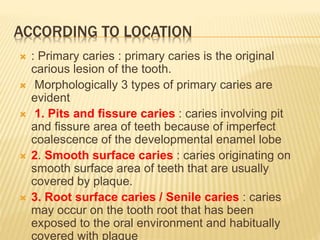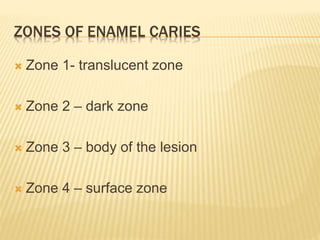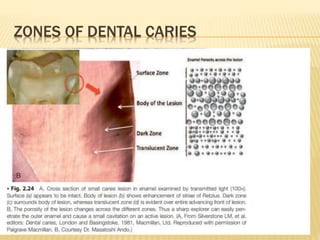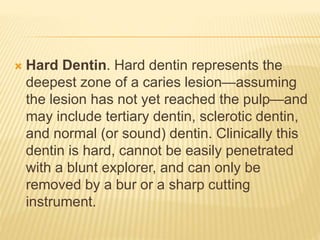DENTAL CARIES classification, types, treatment and prognosis
- 1. DENTAL CARIES Presented by ŌĆō Dr. ANURAG JAIN
- 2. DEFINITION ’āÆ Dental caries is a preventable, chronic, and bioilm-mediated disease modulated by diet. his multifactorial, oral disease is caused primarily by an imbalance of the oral lora (bioilm) due to the presence of fermentable dietary carbohydrates on the tooth surface over time. ’āÆ - Sturdevant 7th edition.
- 3. ’āÆ dental caries lesions result from a dynamic process of damage (demineralization) and restitution (remineralization) of the tooth matter. ’āÆ Understanding the balance between demineralization and remineralization is key to caries management. ’āÆ Repeated demineralization events may result from a predominantly pathologic environment causing the localized dissolution and destruction of the calciied dental tissues, evidenced as a caries lesion.
- 6. CLASSIFICATION ’āÆ caries can be Described according to ’āÆ Location ’āÆ Extent ’āÆ Rate.
- 7. ACCORDING TO LOCATION ’āÆ : Primary caries : primary caries is the original carious lesion of the tooth. ’āÆ Morphologically 3 types of primary caries are evident ’āÆ 1. Pits and fissure caries : caries involving pit and fissure area of teeth because of imperfect coalescence of the developmental enamel lobe ’āÆ 2. Smooth surface caries : caries originating on smooth surface area of teeth that are usually covered by plaque. ’āÆ 3. Root surface caries / Senile caries : caries may occur on the tooth root that has been exposed to the oral environment and habitually covered with plaque
- 10. ’āÆ 2.secondary caries / Recurrent caries - it occurs at junction of a tooth restoration and the tooth and may progress under the restoration.
- 11. ACCORDING TO EXTENT ’āÆ Incipient / Reversible caries : This represents early carious lesion which is in its initial stage. it can be remineralised if immediate corrective measures alter the stage. ’āÆ Cavitated / Irreversible caries: in this condition enamel surface is broken and usually lesion has advanced into dentin. Restoration is usually indicated.
- 12. ACCORDING TO RATE ’āÆ Acute / Rampant caries : it refers to disease that is rapidly damaging the tooth . ’āÆ Chronic / Arrested caries : it is slow or it may be arrested after several active phase.
- 13. ACCODING TO DIRECTION ’āÆ Backward caries : when the spread of caries along DEJ exceeds the caries in the contiguous enamel caries extended in to this enamel from junction and is termed Backward caries. ’āÆ Forward caries : when caries cone in enamel is larger or at least the same size as that dentin.
- 14. BACKWARD & FORWARD CARIES
- 15. ECOLOGIC BASIS OF DENTAL CARIE: THE ROLE OF THE BIOILM ’āÆ Dental plaque is a term historically used to describe the soft, tenacious film accumulating on the surface of teeth. ’āÆ Dental plaque has been more recently referred to as the dental bioilm or simply the bioilm, which is a more complete and accurate description of its composition (bio) and structure.
- 16. ’āÆ the bioilm is composed mostly of bacteria, their by-products, extracellular matrix, and water. ’āÆ the accumulation of the bioilm on teeth is a highly organized and ordered sequence of events. ’āÆ Bacteria seem to occupy the same spatial niche on most individuals. A ŌĆ£hedgehogŌĆØ formation has been recently characterized because of the spine of radially oriented filaments
- 17. ’āÆ the filaments are a mass of Corynebacterium filaments with Streptococcus at the periphery. Actinomyces are usually found at the base of the bioilm suggesting that Corynebacterium attaches to a preexisting bioilm containing Actinomyces.
- 20. ORAL HYGIENE AND ITS ROLE IN THE DENTAL CARIES PROCESS ’āÆ Oral hygiene, accomplished primarily by proper tooth brushing and flossing, is another ecologic determinant of dental caries onset and activity. Careful mechanical cleaning of teeth disrupts the bioilm and leaves a clean enamel surface. the cleaning process does not destroy most of the oral bacteria but merely removes them from the surfaces of teeth.
- 21. SALIVA: NATUREŌĆÖS ANTICARIES AGENT ’āÆ Saliva is an extremely important substance for the proper digestion of foods, and it also plays a key role as a natural anticaries agent ’āÆ the importance of saliva for oral health is dramatically noted after therapeutic radiation to the head and neck. ’āÆ After radiation, salivary glands become fibrotic and produce little or no saliva, leaving the patient experiencing an extremely dry mouth (xerostomia) (xero, dry; stoma, mouth), a condition termed hyposalivation
- 22. ’āÆ Salivary protective mechanisms that maintain the normal oral flora and tooth surface integrity include. ’āÆ bacterial clearance, direct antibacterial activity, buffers, and remineralization.
- 23. BACTERIAL CLEARANCE ’āÆ the flushing effect of this salivary low is, by itself, adequate to remove virtually all microorganisms not adherent to an oral surface.
- 24. DIRECT ANTIBACTERIAL ACTIVITY ’āÆ Salivary glands produce an impressive array of antimicrobial products like Lysozyme, lactoperoxidase, lactoferrin, and agglutinins possess antibacterial activity.
- 25. DIET AND DENTAL CARIES ’āÆ High-frequency exposure to fermentable carbohydrates such as sucrose may be the most important factor in producing cariogenic bioilm and ultimately caries lesions. ’āÆ Dietary sucrose plays a leading role in the development of pathogenic bioilms and may be the most important factor in disruption of the normal healthy ecology of dental bioilm communities.
- 26. ZONES OF ENAMEL CARIES ’āÆ Zone 1- translucent zone ’āÆ Zone 2 ŌĆō dark zone ’āÆ Zone 3 ŌĆō body of the lesion ’āÆ Zone 4 ŌĆō surface zone
- 27. ZONES OF DENTAL CARIES
- 28. ZONES OF DENTINAL CARIES ’āÆ Soft Dentin (formerly infected dentin). ’āÆ Also called outer carious dentin, soft (infected) dentin is primarily characterized by bacterial contamination. ’āÆ It is closer to the tooth surface, characterized by the presence of bacteria, low mineral content, and irreversibly denatured collagen. Histologically this zone may be referred to as necrotic and contaminated
- 29. ’āÆ Firm Dentin (formerly affected dentin). Also called inner carious dentin, firm (affected) dentin is primarily characterized by demineralization of intertubular dentin and of initial formation of intratubular ine crystals at the advancing front of the caries lesion. As the tubule lumen becomes filled with minerals it will give a ŌĆ£transparentŌĆØ appearance in a section observed in a light microscope
- 30. ’āÆ Hard Dentin. Hard dentin represents the deepest zone of a caries lesionŌĆöassuming the lesion has not yet reached the pulpŌĆöand may include tertiary dentin, sclerotic dentin, and normal (or sound) dentin. Clinically this dentin is hard, cannot be easily penetrated with a blunt explorer, and can only be removed by a bur or a sharp cutting instrument.






























